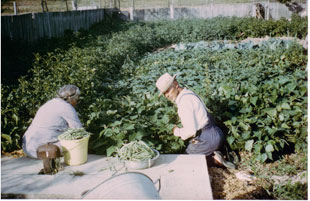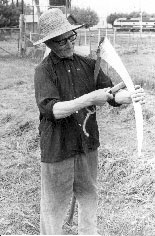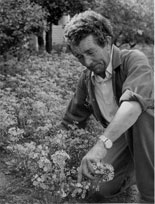Every migrant to Australia carries a heritage of gardening from their country of origin. This heritage is reflected in the choice of plants, garden layout and methods of cultivation.
When post war European migrants settled in Orange in the late 1940s and early 1950s, they started cultivating gardens as soon as they had a house and land. Used to chronic shortages of food during and immediately after World War II, their gardens tended to be utilitarian rather than decorative. They grew all kinds of fruit and vegetables, kept chickens and often a cow on their suburban blocks. No corner of their gardens was wasted.
 |
|
| Many European migrants had large gardens to keep them supplied with fruit and vegetables throughout the year. Jozefa and Stefan Grzejszczak harvest beans in their Bathurst Road garden. | |
| Image courtesy: Lucy Grzejszczak | |
While the main reason for growing fruit and vegetables was to save money, especially in the case of large families, it was also important culturally. After harvest, fruit and vegetables were often preserved in traditional ways to ensure a steady supply of familiar food. Many migrants hated Australian food and yearned for food that reminded them of home, such as sauerkraut, pickled gherkins and other preserves. Gardens full of produce also meant bargaining power, and many migrants bartered one type of produce for another.
 |
Latvian migrant Josef Cudars Senior enjoyed using traditional methods of cultivation in his garden in Orange. |
| Image courtesy: Joe and Wilma Cudars | |
 |
Nazza Pasquali took his gardening skills to his job as gardener at the Email factory. |
| Image courtesy: Email Ltd. | |
